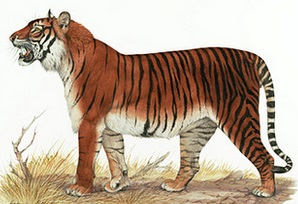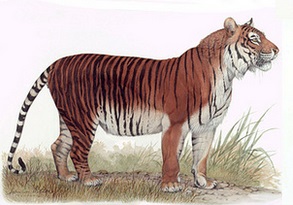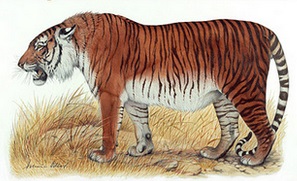Taxonomy
Kingdom |
Phylum |
Class |
Order |
Family |
Genus |
Species |
| Animalia | Chordata | Mammalia | Carnivora | Felidae | Panthera | Panthera tigris |
0

A tiger from the San Diego Zoo
0
Name
- Scientific name: Panthera tigris.
- Common name: Tiger.
Distribution
- There are 8 recognized subspecies of tigers living in 13 Asian countries: India, Nepal, Bangladesh, Bhutan, Myanmar, China, Cambodia, Laos, Myanmar, Malaysia, Vietnam, Russia and North Korea.
- It is possibly extinct in North Korea and regionally extinct in Afghanistan, Iran, Kazakhstan, Kyrgyzstan, Pakistan, Singapore, Tajikistan, Turkmenistan and Uzbekistan.
- According to the IUCN Red List of Threatened Species tigers have lost 93% of their historic range.
- The Indian Subcontinent harbors more than 80% of wild tigers.
- The latest global population estimate by the IUCN is 4,000 adult individuals.

Tiger distribution map. Source: IUCN Red List of Threatened Species.
Habitat
- Tigers live in a variety of habitats due to their wide distribution. A constant requirement is the presence of plenty of prey, source of water and cover.
- Their habitat consists in evergreen forests, swamps, woodlands, grassland, deciduous forests, tropical forests, savannas and rocky habitats.
- They are exposed to a variety of climates, temperatures and elevations. Siberian tigers are exposed to temperatures as low as -40˚.
Population and Subspecies
- Indochinese Tiger. Endangered
- Bengal Tiger. Endangered
- South China Tiger. Critically Endangered
- Sumatran Tiger. Critically Endangered
- Siberian Tiger. Endangered
Indochinese tiger (Panthera tigris corbetti)
- Endangered.
- Their distribution includes the countries of China (south), Cambodia, Laos, Myanmar, Malaysia and Vietnam.
- Scientists estimate that there are 600 to 650 individuals in the wild today. There is restricted access to its habitat therefore the difficulty to obtain accurate numbers.
- Males can reach lengths of up to 113 in or 2.85 m and can weigh up to 430 lb or 195 kg.
- Females can be up to 100.8 in or 2.55 m in length and up to 290 lb or 130 kg in weight.
Bengal tiger (Panthera tigris tigris)
- Endangered.
- They can be found in India, Nepal, Bangladesh, Bhutan and Myanmar.
- This subspecies has the most number of individuals but with a decreasing trend. It is estimated that its population is about 3,000 to 5,000 animals in the wild.
- It is the national animal of India and Bangladesh.
- Males can be up to 120 in or 3.1 m in length and weigh up to 550 lb or 250 kg.
- Females can reach lengths of up to 104 in or 2.65 m and weigh up to 350 lb or 160 kg.
South China tiger (Panthera tigris amoyensis)
- Critically endangered.
- According to the International Union for the Conservation of Nature this subspecies may be functionally extinct as it has not been observed in the wild during the last two decades.This is the most threatened of all living tiger species.
- Current range is South China.
- Males can reach lengths of up to 104 in or 2.65 m and weigh up to 359 lb or 175 kg.
- Females can be up to 94 in or 2.4 m long and weigh up to 254 lb or 115 kg.
Sumatran tiger (Panthera tigris sumatrae)
- Critically endangered.
- It can only be found in the wild on the island of Sumatra in Indonesia.
- Its population is estimated at between 400 to 500 individuals.
- This is the only subspecies of the Sundra island group in the Malay archipelago that survives. The other two subspecies, the Bali and Javan tigers are extinct.
- Sumatran tigers are the smallest subspecies and can reach up to 89 in or 2.25 m and weigh up to 310 lb or 140 kg.
Siberia or Amur tiger (Panthera tigris altaica)
- Endangered.
- Its current range includes Eastern Russia, northeast China and North Korea.
- The latest estimate of its population was done in 2010 which calculated approximately 400 individuals in the Sikhote Alin Mountains in Western Russia where about 90% of the Siberian tiger population occurs. Another 15 to 20 animals were estimated in the Russian border with north east China.
- Scientists have noted that there is little genetic exchange and geographical dispersal of this subspecies.
- During the 1930s its population fell to 20-30 individuals.
- Because of the partial growth in the number of Amur tigers the IUCN changed its status in 2007 from critically endangered to endangered. Since then its population has been declining.
- Siberian tigers are the largest subspecies and can reach lengths of up to 145 in or or 3.7 m. They can weigh up to 932 lb or 423 k.
Bali tiger (Panthera tigris balica)
- Extinct. Island of Bali in Indonesia.
Javan tiger (panther tigris sondaica)
- Extinct. Island of Java in Indonesia.
Caspian tiger (Panthera tigris virgata)
- Extinct. Afghanistan, Iran, Iraq, Turkey and parts of Russia.
Physical Features
- Tigers are the largest cats living on earth.
- Its coat is orange brown with vertical black stripes. The arrangement of the stripes is unique in each individual. The stripes are not only on the fur but also on the skin and they cover its head, tail, body and limbs.
- The color of its coat and body size varies among subspecies.
- Its belly, chest, underside of the limbs and throat are white.
- They have long retractable claws that help them climb.
- Its tongue is covered by hard papillae.
Size and length
- Siberian tigers, also known as Amur tigers, are the largest subspecies.
- Male Siberian tigers can measure up to 12.13 feet or 3.7 meters and weigh up to 932 lbs or 423 kilos.
- Female Siberian tigers can measure up to 7.9 feet 2.4 meters and weigh up to 370 lbs or 168 kilos.
- The smallest subspecies is the Sumatran tiger.
- Male Sumatran tigers can reach lengths of up to 7.7 feet or 2.34 meters and weight 300 lbs or 136 kilos.
- Female Sumatran tigers can be 6.5 feet or 1.98 meters long and weigh 198 lbs or 90 kilos.
Behavior
- Tigers are strong swimmers and climbers.
- They establish their home range by spraying trees and rocks in their territory with urine, scraping trees and marking trails with scat.
- The size of a home range depends on density. Tigers will defend their home range but would let another tiger who has shown submission to share part of it so their home ranges would overlap.
- Females establish their territories near their mother’s while males disperse further.
- They communicate by roars, growls, moans, hisses and mews. Each vocalization has a meaning. For instance moans means submission while roars dominance.
- They also communicate by facial expressions. An example is the defense threat when the tiger exposes its teeth, flatten its ears and their pupils dilate.
- Tigers build dens in dense vegetation, caves, in a hollow tree or under a fallen tree.
- Tigers prefer to hunt at night. They locate their prey using sight and hearing.
- They hunt by ambushing the prey and biting them in the jugular vein in the neck suffocating it and rendering it motionless. The prey cannot go further because of heavy bleeding. After killing its prey the tiger drags it to a safe place where it covers it with vegetation saving it for the next days.
Diet
- Tigers are carnivore mammals. They eat large and small mammals, birds, fish and reptiles.
Reproduction
- Female tigers reach reproductive maturity between 3 and 4 years old, while males between 4 and 5.
- Males compete for females and breed at any time of the year. Tigers are polygynandrous meaning that they breed with multiple partners.
- Females give birth every 3 to 4 years.
- Gestation lasts an average of 103 days.
- Litter size is 1 to 7 with an average of 2 to 3.
The Young
- Newborns are blind and weigh from 1.72 to 3.53 lbs or 780 to 1600 grams.
- Their eyes open after 6 to 14 days after birth.
- They are weaned at around 3 months but stay with their mother until they are 3 years old.
- Males do not provide parental care.
Life Expectancy
- Tigers live from 8 to 10 years in the wild and up to 26 in captivity.
Predators
- The tiger has no natural predators other than humans.
Threats
- Tiger parts have been used for thousands of years in traditional Chinese medicine.
- Their fur is used to make rugs.
- Fragmentation of their natural habitat has resulted in collisions with humans.
- Loss of larger prey species.
Did you know?
- A white tiger is a result of inbreeding. Their white fur is due to two recessive forms of a gene inherited from their parents. Populations of white Bengal tigers exist in India. White South China tigers are known as Maltese tigers and they have white bluish fur.
- In 2011 the board of directors for the American Zoological Association (AZA) banned the breeding of white tigers because it has been clearly linked to various abnormal, debilitating, and, at times, lethal, external and internal conditions and characteristics.
References and further research
Cambridge University Press Journal of Zoology
Panthera, Leaders in Wildlife Conservation – Tiger Subspecies
University of Michigan Museum of Zoology – Panthera tigris Tiger
Google Scholar – Panthera tigris
Convention on International Trade in Endangered Species of Wildlife and Flora
Convention on International Trade in Endangered Species of Wildlife and Flora.







